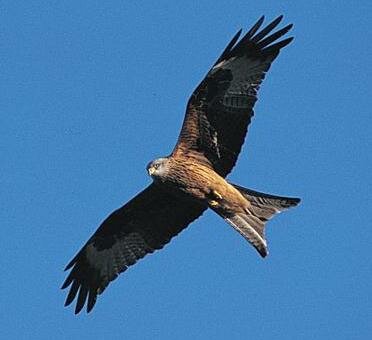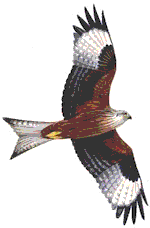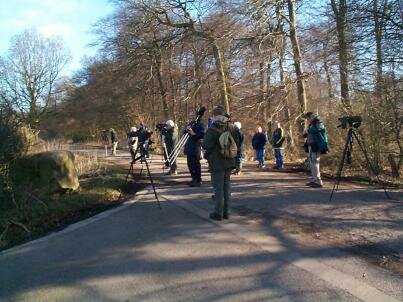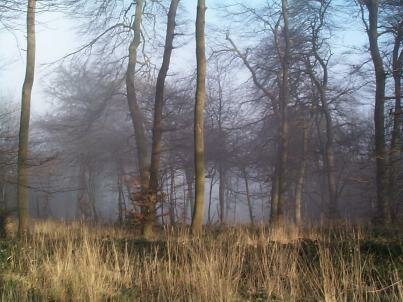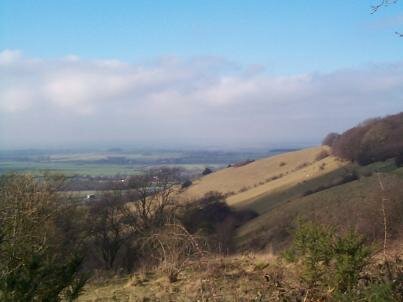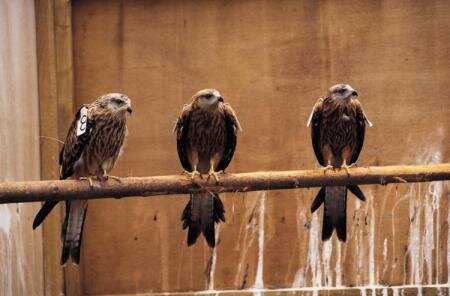The coach trip to the Chilterns to see the Red Kites was organised by Brian Dawson of Nature Break Wildlife Cruises. We started off at Aston Rowant National Nature Reserve, Stokenchurch, Oxfordshire to stand on the now famous viewing platform that offers commanding views over the Chiltern Hills. Despite a period of thick mist this soon cleared to offer us wonderful views of over 40 individual kites and at least 8 Common Buzzards.
The Red KiteOnce widespread and a common sight in many parts of the UK, persecution of the Red Kite led to its extinction everywhere but in mid-Wales by the late 19th century. This magnificently graceful bird of prey was saved from national extinction by one of the world's longest running protection programmes, and has now been successfully re-introduced to England and Scotland. The adult Red Kite is a large bird, 60-66cm in length with a wingspan of 175-195cm. Its body is rusty chestnut-brown with a paler golden to white head with fine dark streaks. While soaring it shows narrow-fingered dark wings, with large whitish patches on the inner part of the wing. In flight the wings are angled at the wrist and slightly arched. The Red Kite is most easily distinguished by its characteristic forked pale chestnut tail. The kite's legs are a bright yellow, as are its eyes and black-tipped beak. The Red Kite hangs on rising air and weaves slowly with a powerful flight, tilting its long tail from side to side to act as a rudder. Its calls include a mewing, similar to a buzzard, and a high whistling. Apart from a few pairs in Morocco, the entire world population of Red Kites are found in Europe. An estimated 19,000-37,000 breeding pairs are found in Europe, from Sweden and Denmark in the north to Spain and Italy in the south. The only native colony of Red Kites in the UK is in Wales and in 2000 this numbered around 260 pairs. Since 1989 five new breeding populations in England and Scotland have been established through a re-introduction scheme. Initially, young kites were brought in from Spain, Sweden and Germany, but the success of the breeding population in the Chilterns means that chicks from those nests here can now be translocated to sites elsewhere in the country. Results from the re-introduction programme are encouraging, with numbers increasing steadily in sites in the Chilterns, Midlands, Central Scotland and North Scotland. In 2000 a national survey revealed that more than 100 breeding pairs were located in the Chilterns, successfully raising over 200 young. In the Midlands, 16 pairs were located with 10 pairs rearing 22 young. In Yorkshire, 23 kites were released in 1999, the first year of the project on the Harewood Estate. These are beginning to pair up and one pair raised 2 young in 2000, at the same time that a further 19 birds were released. In North Scotland, in 2000, 32 pairs reared 74 young, and in Central Scotland 7 pairs reared 10 young (and 20 more kites were released).
With grateful thanks to Brian Dawson for a very rewarding and well organised trip. |
Page last updated:
Web Design Graham Mee. ? Copyright of all pages South East Essex RSPB Local Group. All images copyright of owners
The Royal Society for the Protection of Birds. Registered charity no 207076


